Pumping Station Desing - Second Edition by Robert L. Sanks, George Tchobahoglous, Garr M. Jones
Подождите немного. Документ загружается.

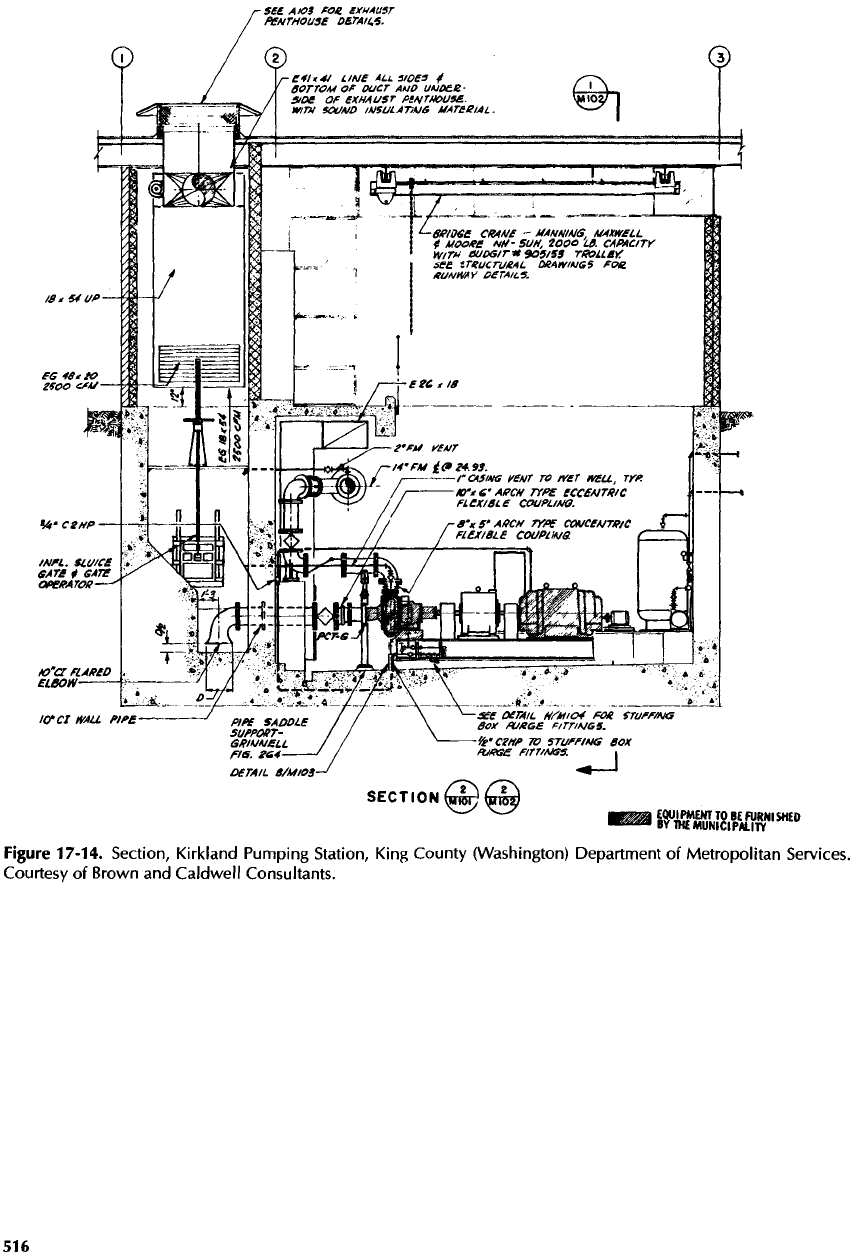
Figure
17-14.
Section, Kirkland Pumping
Station,
King County (Washington) Department
of
Metropolitan
Services.
Courtesy
of
Brown
and
Caldwell Consultants.

Example
17-5
North
Mercer
Island
Pumping
Station
The
North Mercer Island Pumping Station (Figures 17-15 through
17-17),
which
was
built
in
1969,
is
exceptionally deep
(13.7
m or 45
ft).
It is
located
in a
quiet residential neighborhood
where
aesthetics (architectural treatment
and
control
of
odor, sound,
and
light emissions)
all
were
of
concern.
The
station
had to
have
the
appearance
of a
modern ranch house
to
match nearby struc-
tures.
The
typical cyclone fence,
so
common
to
most municipal wastewater pumping stations,
had
to
be
avoided
at all
costs.
A
small stream, which coursed through
the
site,
had to be
preserved.
The
sylvan
character
of the
site,
if
anything,
had to be
enhanced
by the
proposed improvements.
Each
of the
pumps
is
rated
1.1
m
3
/s
(2.6
Mgal/d)
against
a
total head
of 43 m
(140 ft).
The
force
main route,
the
only economically feasible selection, featured
a
plateau
at
approximately
the
middle half
of its
760-m
(2500-ft)
length. This plateau
was at an
elevation that corresponded
roughly
to
two-thirds
of the
total static head. From
a
transient analysis,
it was
determined that
column
separation
was
likely
to
occur upon power
failure
at
maximum pumping rates.
The
solu-
tion
was to
specify
the
pumps
to be
driven
by
wound-rotor, specially designed motors incorpo-
rating
flywheels
that have rotating moments
of
inertia
sufficient
to
prevent column separation
under
the
worst conditions.
The
motor speeds
are
controlled
by a
liquid rheostat
and
adjusted
to
maintain
normal
depth-of-flow
conditions
in the
upstream sewer.
The
noise suppression measures include
the
following:
• The
pump drive motors
are
specially designed
for
quiet operation.
• The
pump drive motors
are
located
in a
below-grade
room with
all
access openings
fitted
with
hatches
or
doors.
Figure
17-15.
Pump
room
plan,
North
Mercer
Island
Pumping
Station, King
County
(Washington)
Department
of
Metropolitan
Services.
Courtesy
of
Brown
and
Caldwell
Consultants.

Figure
17-16.
Motor
room
and wet
well
plan,
North
Mercer
Island
Pumping
Station,
King
County
(Washington)
Department
of
Metropolitan
Services. Courtesy
of
Brown
and
Caldwell
Consultants.
• All
walls
above grades
are of
double-wall
construction
with
a
sound-absorbing
filler
between them.
•
Double glazing (with nonparallel panes)
is
used
for all
windows.
The
panes
of
synthetic, bul-
letproof glass
are
resilient
to
absorb energy.
• The
heavy transformer enclosure
is
located two-thirds
of a
wavelength
from
the
transformer
shell.
The
walls
are
high enough
to
focus
a
60-Hz
hum
upward.
• A
special sound-absorbing design
is
used
for air
inlet louvers.
• The
design criteria included extra-heavy construction
for all
substructure
and
superstructure
floors
to
prevent sound transmission
to
adjacent soils.
• All
ventilation systems discharge upward with special enclosures
to
focus
sound upward.
All
above-grade lighting systems were designed
to
mimic residential lighting except when
maintenance
is
required. Odor suppression measures included variable-speed pumping
to
main-
tain clean upstream sewers
and a
self-cleaning
wet
well. Originally,
a dry
scrubber with
pellets
of
potassium permanganate
and
alumina
was
installed
on the
ventilation exhaust. However,
material costs were very high, charging
the
reactors with
pellets
was
labor intensive,
and—
worst
of
all—odor
removal
was
poor.
The
system
was
replaced with
a
mist scrubber that
removes
95% of the
H
2
S.
[Ed. note:
a
passerby would smell nothing,
would
hear nothing
but
the
brook
and the
wind
in the
trees,
and
would assume
the
structure
to be an
attractive residence
with
an
attached double garage
and a
wide
driveway,]
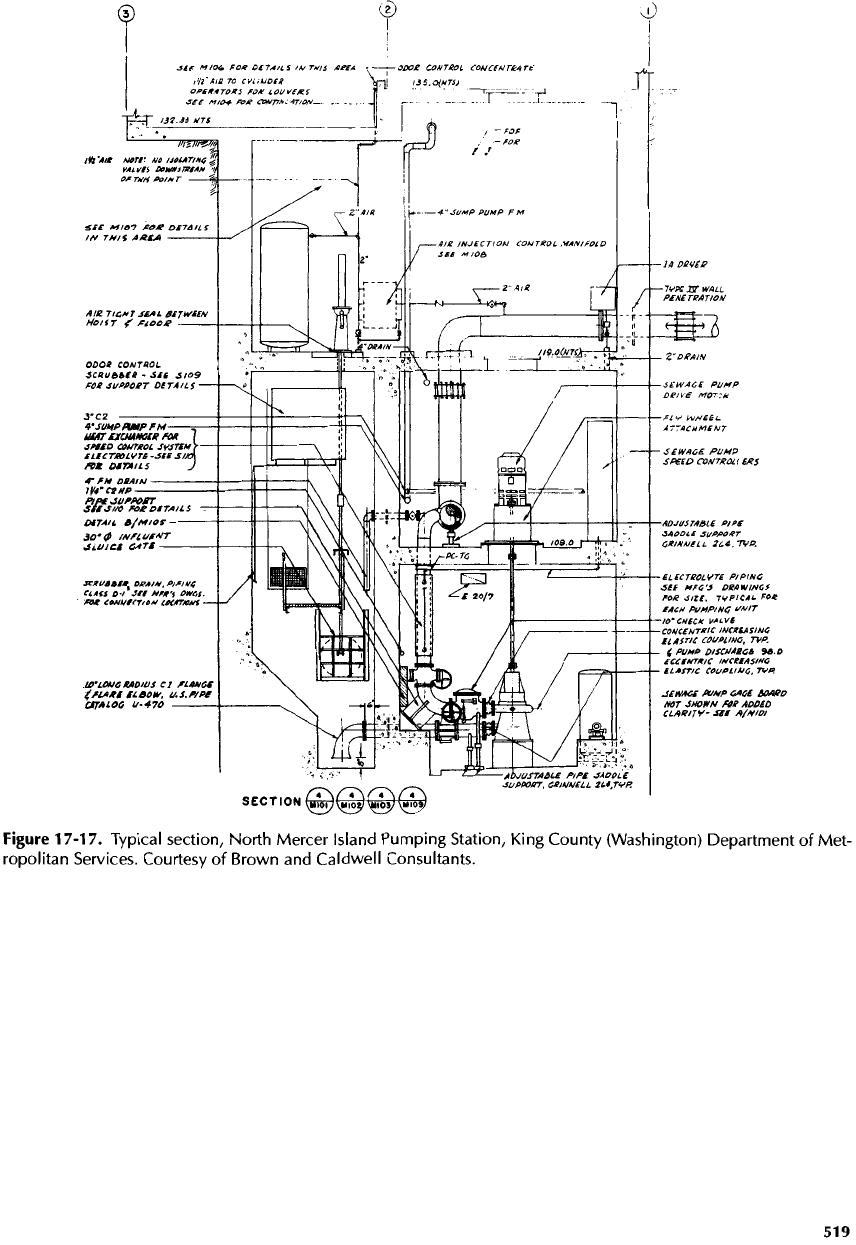
Figure
17-17.
Typical section,
North
Mercer Island Pumping Station, King County (Washington) Department
of
Met-
ropolitan
Services.
Courtesy
of
Brown
and
Caldwell
Consultants.
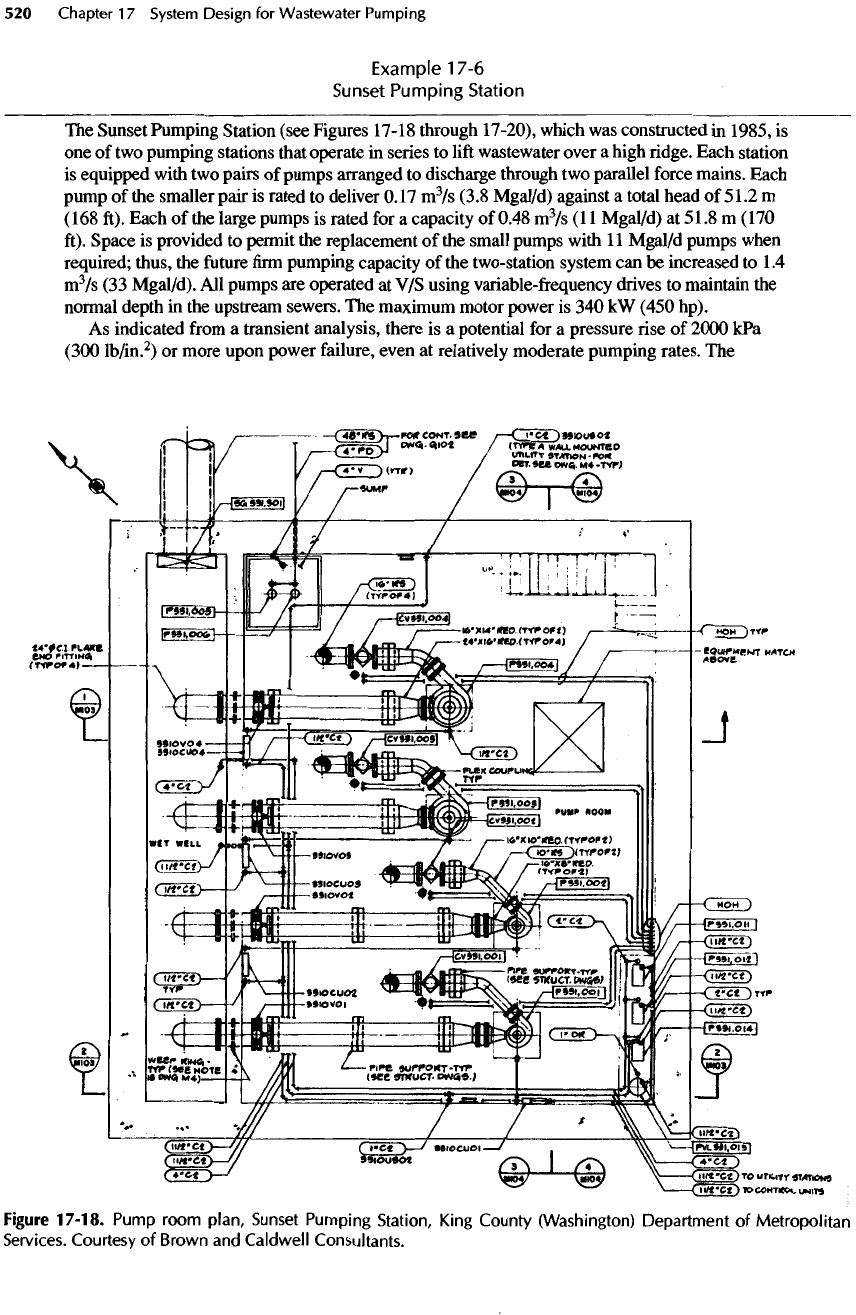
Example
17-6
Sunset
Pumping
Station
The
Sunset Pumping Station (see Figures 17-18 through 17-20), which
was
constructed
in
1985,
is
one of two
pumping stations that operate
in
series
to
lift
wastewater over
a
high ridge. Each station
is
equipped with
two
pairs
of
pumps arranged
to
discharge through
two
parallel force mains. Each
pump
of the
smaller pair
is
rated
to
deliver
0.17
m
3
/s
(3.8
Mgal/d)
against
a
total head
of
51.2
m
(168
ft).
Each
of the
large pumps
is
rated
for a
capacity
of
0.48
m
3
/s
(11
Mgal/d)
at
51.8
m
(170
ft).
Space
is
provided
to
permit
the
replacement
of the
small pumps with
11
Mgal/d pumps when
required; thus,
the
future
firm
pumping capacity
of the
two-station system
can be
increased
to
1.4
m
3
/s
(33
Mgal/d).
All
pumps
are
operated
at V/S
using variable-frequency drives
to
maintain
the
normal
depth
in the
upstream sewers.
The
maximum motor power
is 340 kW
(450 hp).
As
indicated
from
a
transient analysis, there
is a
potential
for a
pressure
rise of
2000
kPa
(300
lb/in.
2
)
or
more upon power failure, even
at
relatively moderate pumping rates.
The
Figure
17-18.
Pump room
plan,
Sunset
Pumping Station, King County (Washington) Department
of
Metropolitan
Services.
Courtesy
of
Brown
and
Caldwell Consultants.
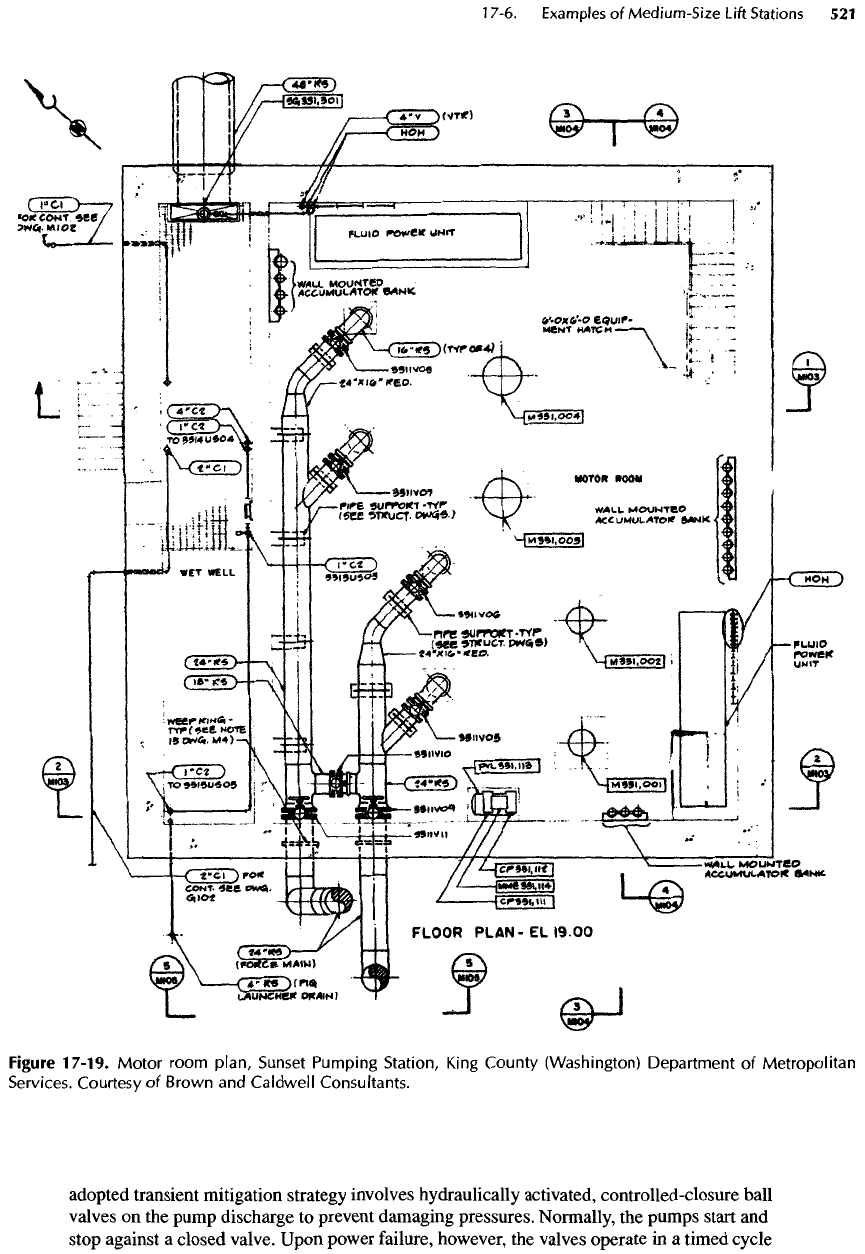
Figure
17-19.
Motor
room
plan,
Sunset
Pumping
Station,
King County (Washington) Department
of
Metropolitan
Services.
Courtesy
of
Brown
and
Caldwell
Consultants.
adopted
transient mitigation strategy involves hydraulically activated, controlled-closure ball
valves
on the
pump discharge
to
prevent damaging pressures. Normally,
the
pumps start
and
stop against
a
closed
valve. Upon power failure, however,
the
valves operate
in a
timed cycle
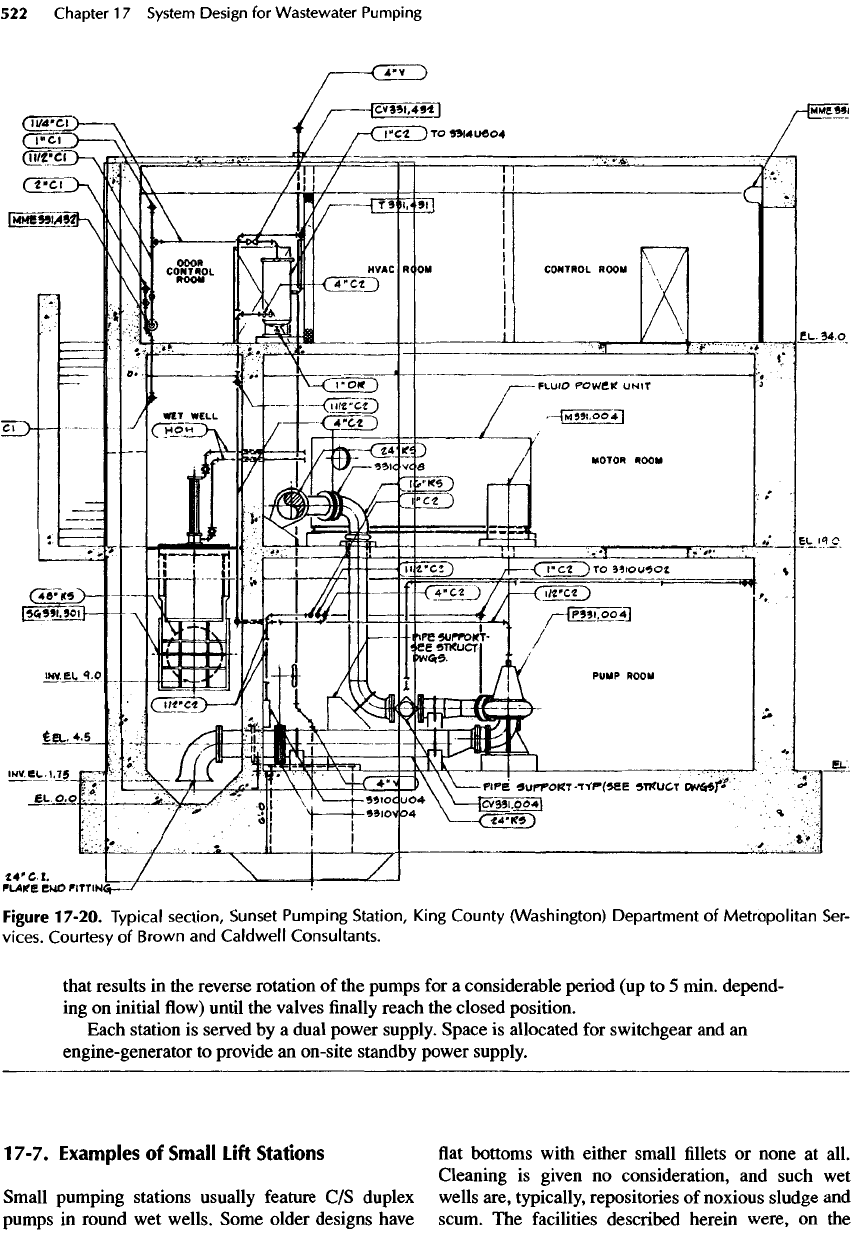
1
7-7.
Examples
of
Small
Lift
Stations
Small
pumping stations usually feature
C/S
duplex
pumps
in
round
wet
wells. Some older designs have
flat
bottoms with either small
fillets or
none
at
all.
Cleaning
is
given
no
consideration,
and
such
wet
wells
are,
typically, repositories
of
noxious sludge
and
scum.
The
facilities described herein were,
on the
Figure
17-20.
Typical section,
Sunset
Pumping Station, King County (Washington) Department
of
Metropolitan
Ser-
vices.
Courtesy
of
Brown
and
Caldwell
Consultants.
that
results
in the
reverse rotation
of the
pumps
for a
considerable period
(up to 5
min.
depend-
ing on
initial
flow)
until
the
valves
finally
reach
the
closed position.
Each station
is
served
by a
dual power supply.
Space
is
allocated
for
switchgear
and an
engine-generator
to
provide
an
on-site standby power supply.
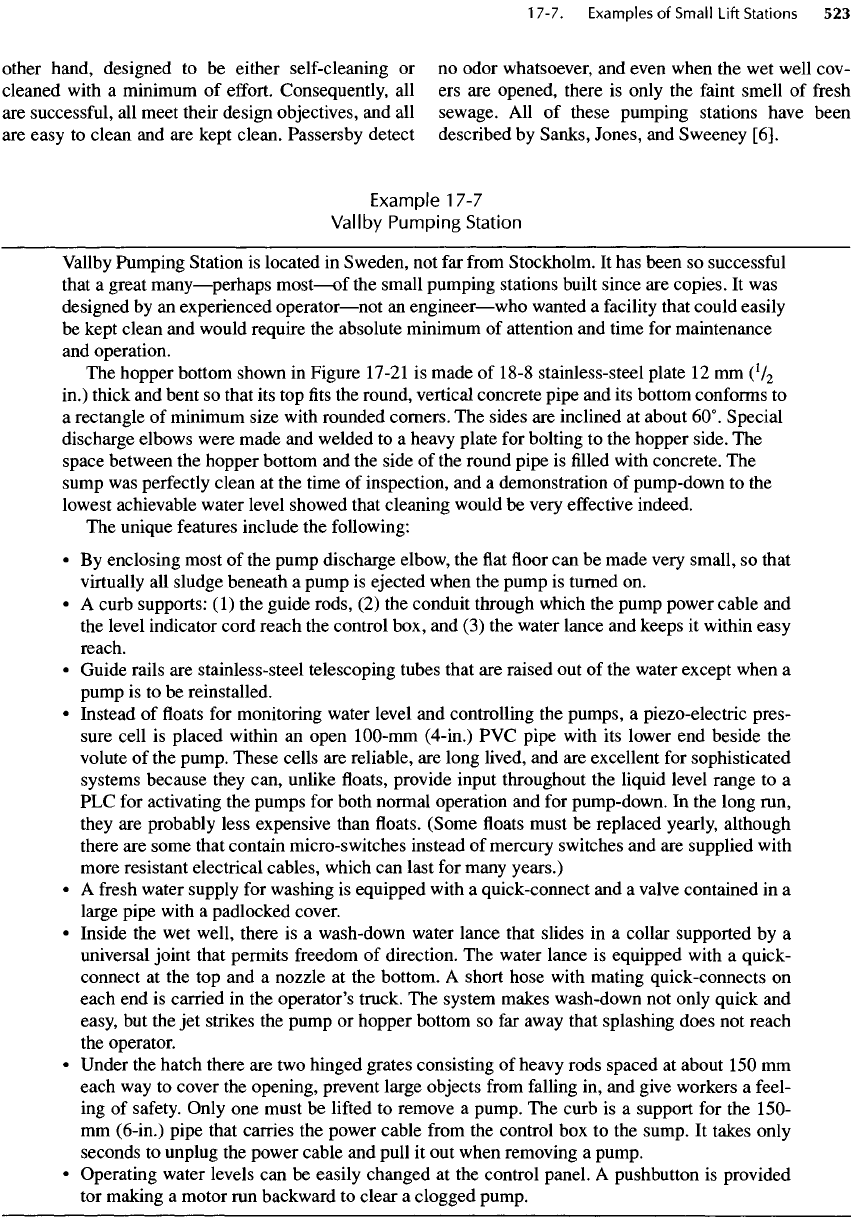
other hand, designed
to be
either self-cleaning
or
cleaned
with
a
minimum
of
effort.
Consequently,
all
are
successful,
all
meet their design objectives,
and all
are
easy
to
clean
and are
kept clean. Passersby detect
no
odor whatsoever,
and
even when
the wet
well cov-
ers are
opened, there
is
only
the
faint
smell
of
fresh
sewage.
All of
these pumping stations have been
described
by
Sanks,
Jones,
and
Sweeney
[6].
Example
1 7-7
Vallby Pumping Station
Vallby
Pumping Station
is
located
in
Sweden,
not far
from
Stockholm.
It has
been
so
successful
that
a
great
many—perhaps
most—of
the
small pumping stations built
since
are
copies.
It was
designed
by an
experienced
operator—not
an
engineer—who
wanted
a
facility
that could easily
be
kept clean
and
would require
the
absolute minimum
of
attention
and
time
for
maintenance
and
operation.
The
hopper bottom shown
in
Figure 17-21
is
made
of
18-8
stainless-steel plate
12 mm
(
l
/
2
in.) thick
and
bent
so
that
its top fits the
round, vertical concrete pipe
and its
bottom conforms
to
a
rectangle
of
minimum size with rounded corners.
The
sides
are
inclined
at
about 60°.
Special
discharge elbows were made
and
welded
to a
heavy plate
for
bolting
to the
hopper side.
The
space between
the
hopper bottom
and the
side
of the
round pipe
is filled
with concrete.
The
sump
was
perfectly clean
at the
time
of
inspection,
and a
demonstration
of
pump-down
to the
lowest achievable water level showed that cleaning would
be
very
effective
indeed.
The
unique features include
the
following:
• By
enclosing most
of the
pump discharge elbow,
the flat floor can be
made very small,
so
that
virtually
all
sludge beneath
a
pump
is
ejected when
the
pump
is
turned
on.
• A
curb supports:
(1)
the
guide rods,
(2) the
conduit through which
the
pump power cable
and
the
level indicator cord reach
the
control box,
and (3) the
water lance
and
keeps
it
within easy
reach.
•
Guide rails
are
stainless-steel telescoping tubes that
are
raised
out of the
water except when
a
pump
is to be
reinstalled.
•
Instead
of floats for
monitoring water level
and
controlling
the
pumps,
a
piezo-electric
pres-
sure
cell
is
placed within
an
open
100-mm
(4-in.)
PVC
pipe with
its
lower
end
beside
the
volute
of the
pump.
These
cells
are
reliable,
are
long lived,
and are
excellent
for
sophisticated
systems
because they can, unlike
floats,
provide input throughout
the
liquid level range
to a
PLC for
activating
the
pumps
for
both normal
operation
and for
pump-down.
In the
long run,
they
are
probably less expensive than
floats.
(Some
floats
must
be
replaced yearly, although
there
are
some that contain micro-switches instead
of
mercury switches
and are
supplied with
more resistant
electrical
cables,
which
can
last
for
many years.)
• A
fresh
water supply
for
washing
is
equipped with
a
quick-connect
and a
valve contained
in a
large pipe with
a
padlocked cover.
•
Inside
the wet
well, there
is a
wash-down water lance that slides
in a
collar supported
by a
universal
joint that permits freedom
of
direction.
The
water lance
is
equipped with
a
quick-
connect
at the top and a
nozzle
at the
bottom.
A
short hose with mating quick-connects
on
each
end is
carried
in the
operator's
truck.
The
system makes wash-down
not
only quick
and
easy,
but the jet
strikes
the
pump
or
hopper bottom
so far
away that splashing does
not
reach
the
operator.
•
Under
the
hatch there
are two
hinged grates consisting
of
heavy rods spaced
at
about
150
mm
each
way to
cover
the
opening, prevent large objects
from
falling
in, and
give workers
a
feel-
ing of
safety. Only
one
must
be
lifted
to
remove
a
pump.
The
curb
is a
support
for the
150-
mm
(6-in.) pipe that carries
the
power cable
from
the
control
box to the
sump.
It
takes only
seconds
to
unplug
the
power cable
and
pull
it out
when removing
a
pump.
•
Operating water levels
can be
easily changed
at the
control panel.
A
pushbutton
is
provided
tor
making
a
motor
run
backward
to
clear
a
clogged pump.
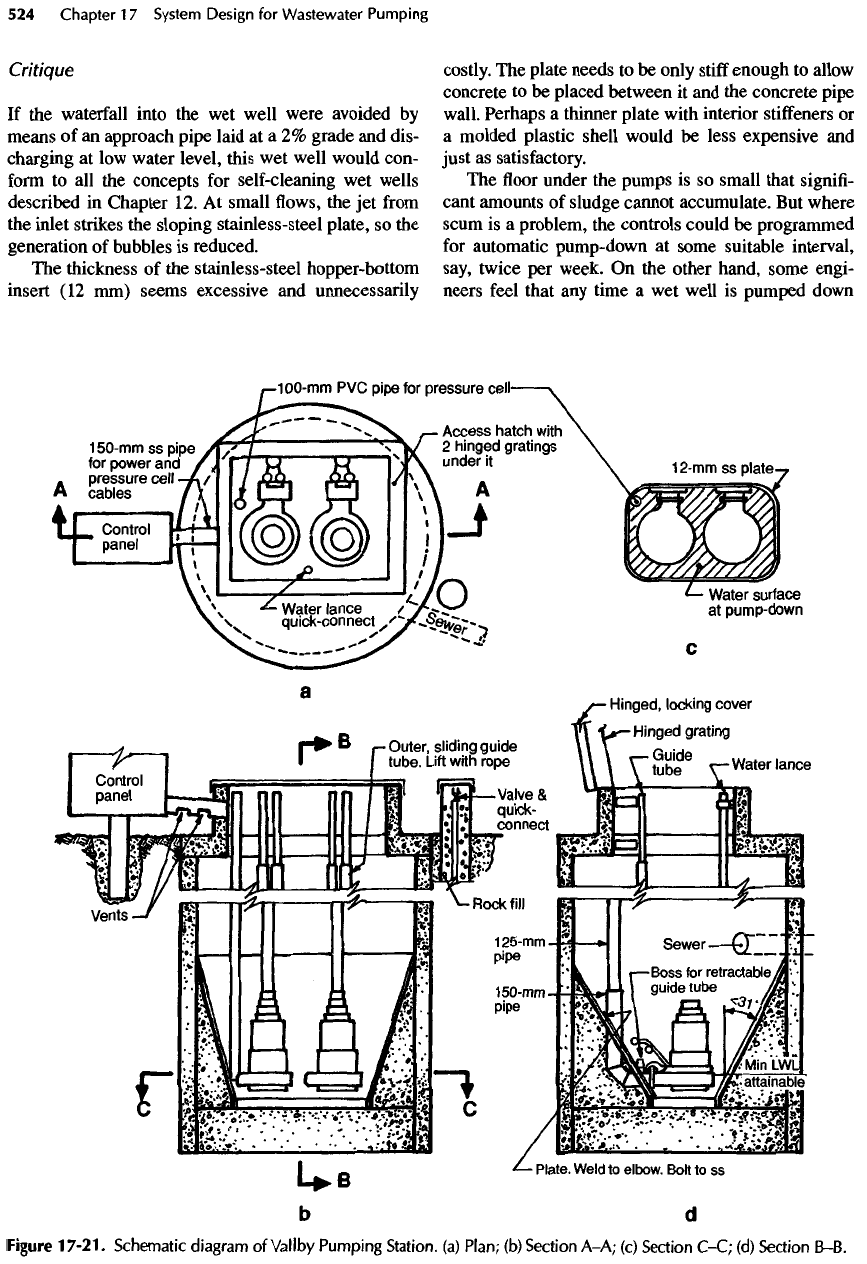
Critique
If
the
waterfall
into
the wet
well were avoided
by
means
of an
approach pipe laid
at a 2%
grade
and
dis-
charging
at low
water
level,
this
wet
well would
con-
form
to all the
concepts
for
self-cleaning
wet
wells
described
in
Chapter
12. At
small
flows, the jet
from
the
inlet
strikes
the
sloping
stainless-steel
plate,
so the
generation
of
bubbles
is
reduced.
The
thickness
of the
stainless-steel hopper-bottom
insert
(12 mm)
seems excessive
and
unnecessarily
costly.
The
plate needs
to be
only
stiff
enough
to
allow
concrete
to be
placed between
it and the
concrete pipe
wall.
Perhaps
a
thinner plate with interior
stiffeners
or
a
molded plastic shell would
be
less
expensive
and
just
as
satisfactory.
The floor
under
the
pumps
is so
small that
signifi-
cant amounts
of
sludge cannot accumulate.
But
where
scum
is a
problem,
the
controls could
be
programmed
for
automatic pump-down
at
some suitable interval,
say,
twice
per
week.
On the
other hand, some engi-
neers feel that
any
time
a wet
well
is
pumped down
Figure
17-21.
Schematic diagram
of
Vallby Pumping
Station,
(a)
Plan;
(b)
Section A-A;
(c)
Section
C-C;
(d)
Section B-B.
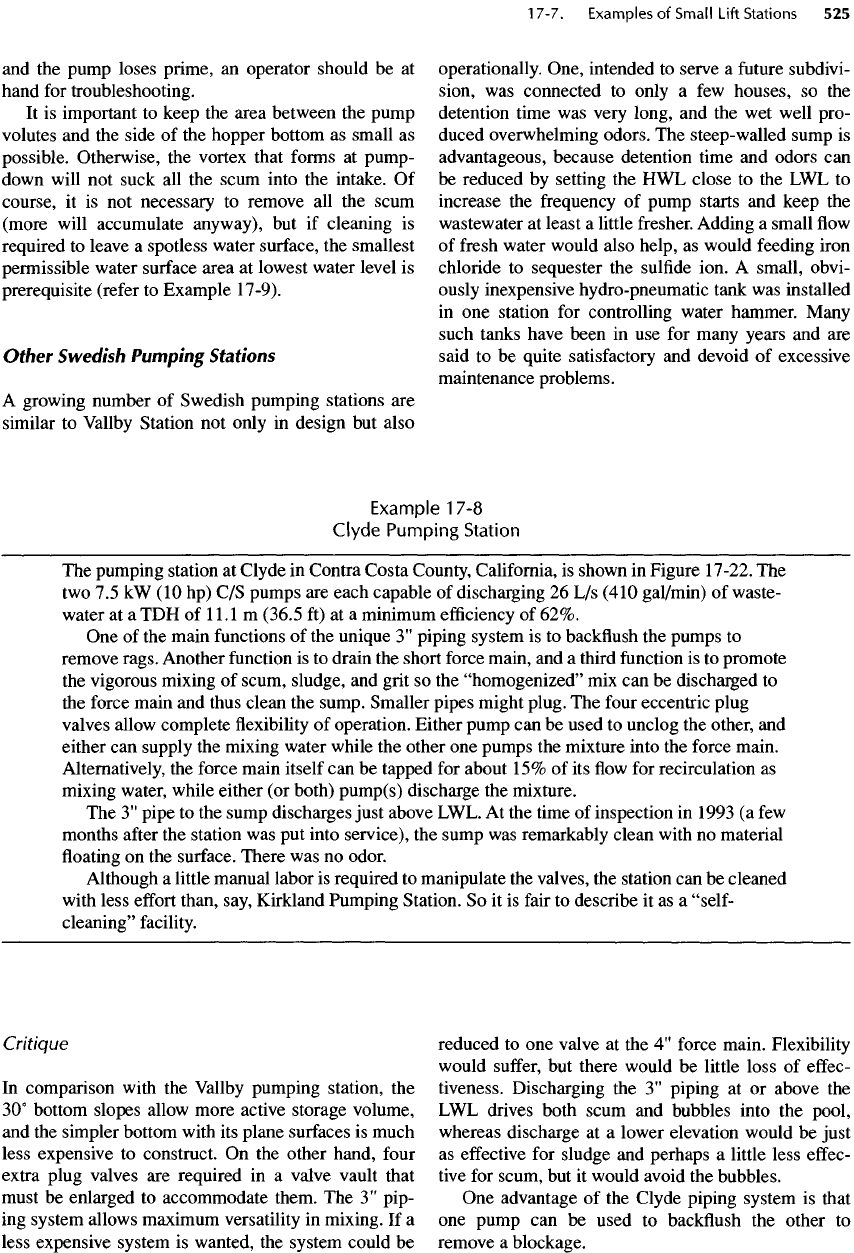
and
the
pump loses prime,
an
operator should
be at
hand
for
troubleshooting.
It
is
important
to
keep
the
area between
the
pump
volutes
and the
side
of the
hopper bottom
as
small
as
possible. Otherwise,
the
vortex that
forms
at
pump-
down
will
not
suck
all the
scum into
the
intake.
Of
course,
it is not
necessary
to
remove
all the
scum
(more will accumulate anyway),
but if
cleaning
is
required
to
leave
a
spotless water surface,
the
smallest
permissible water
surface
area
at
lowest water level
is
prerequisite
(refer
to
Example
17-9).
Other
Swedish
Pumping
Stations
A
growing number
of
Swedish pumping stations
are
similar
to
Vallby Station
not
only
in
design
but
also
operationally. One, intended
to
serve
a
future
subdivi-
sion,
was
connected
to
only
a few
houses,
so the
detention time
was
very long,
and the wet
well pro-
duced overwhelming odors.
The
steep-
walled
sump
is
advantageous, because detention time
and
odors
can
be
reduced
by
setting
the HWL
close
to the LWL to
increase
the
frequency
of
pump starts
and
keep
the
wastewater
at
least
a
little
fresher.
Adding
a
small
flow
of
fresh
water would also help,
as
would feeding iron
chloride
to
sequester
the
sulfide
ion.
A
small, obvi-
ously inexpensive hydro-pneumatic tank
was
installed
in
one
station
for
controlling water hammer. Many
such
tanks have been
in use for
many years
and are
said
to be
quite satisfactory
and
devoid
of
excessive
maintenance problems.
Example
17-8
Clyde Pumping Station
The
pumping station
at
Clyde
in
Contra Costa County, California,
is
shown
in
Figure 17-22.
The
two
7.5 kW
(10
hp) C/S
pumps
are
each capable
of
discharging
26 L/s
(410
gal/min)
of
waste-
water
at a TDH of
11.1
m
(36.5
ft) at a
minimum
efficiency
of
62%.
One of the
main
functions
of the
unique
3"
piping system
is to
backflush
the
pumps
to
remove rags. Another
function
is to
drain
the
short force main,
and a
third
function
is to
promote
the
vigorous mixing
of
scum, sludge,
and
grit
so the
"homogenized"
mix can be
discharged
to
the
force main
and
thus clean
the
sump. Smaller pipes might plug.
The
four
eccentric
plug
valves allow complete
flexibility of
operation. Either pump
can be
used
to
unclog
the
other,
and
either
can
supply
the
mixing water while
the
other
one
pumps
the
mixture into
the
force main.
Alternatively,
the
force main itself
can be
tapped
for
about
15%
of its flow for
recirculation
as
mixing
water, while either
(or
both) pump(s) discharge
the
mixture.
The
3"
pipe
to the
sump discharges just above LWL.
At the
time
of
inspection
in
1993
(a few
months
after
the
station
was put
into service),
the
sump
was
remarkably clean with
no
material
floating
on
the
surface. There
was no
odor.
Although
a
little manual labor
is
required
to
manipulate
the
valves,
the
station
can be
cleaned
with
less
effort
than, say, Kirkland Pumping Station.
So it is
fair
to
describe
it as a
"self-
cleaning"
facility.
Critique
In
comparison with
the
Vallby pumping station,
the
30°
bottom slopes allow more active storage volume,
and
the
simpler bottom with
its
plane surfaces
is
much
less expensive
to
construct.
On the
other hand,
four
extra plug valves
are
required
in a
valve vault that
must
be
enlarged
to
accommodate them.
The 3"
pip-
ing
system allows maximum versatility
in
mixing.
If a
less expensive system
is
wanted,
the
system could
be
reduced
to one
valve
at the 4"
force main. Flexibility
would
suffer,
but
there would
be
little loss
of
effec-
tiveness. Discharging
the
3"
piping
at or
above
the
LWL
drives both scum
and
bubbles into
the
pool,
whereas discharge
at a
lower elevation would
be
just
as
effective
for
sludge
and
perhaps
a
little
less
effec-
tive
for
scum,
but it
would avoid
the
bubbles.
One
advantage
of the
Clyde piping system
is
that
one
pump
can be
used
to
backflush
the
other
to
remove
a
blockage.
